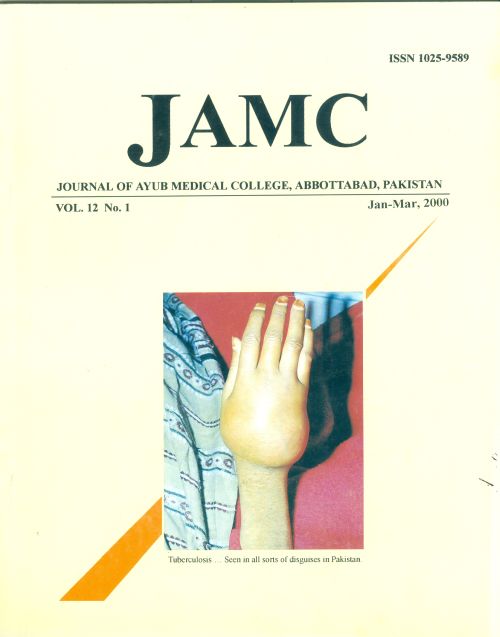THE ROLE OF SURGERY IN HOMOZYGOUS β-THALASSAEMIA
Abstract
Background: Various Strategies are adopted for the control and management of thalassaemia. Despite advances in themedical management of thalassaemia there remains a definite place for splenectomy in the management of
thalassaemia, particularly in a developing country like Pakistan. Methods: The Surgical aspects of the management of
patients with homozygous (3-thalassaemia are reviewed, and operative findings in 15 patients with the disease who
were subjected to splenectomy are described. Results: Post-operatively frequency of blood transfusion was reduced
for maintaining the haemoglobin level, due to decreased blood consumption. The age range was from 12-13 years.
Hepatomegaly was present in all the cases. In 73 percent cases hyperplastic lymph nodes containing erythropoietic
elements were found. Cholelithiasis was seen in only one case. The recovery' was smooth in 10 (67%) cases. Wound
infection developed in 2 cases. Pneumonia occurred in only one case. Two patients developed fever and one items
which responded to conservative treatment.
References
Khattak FM, Saleem M. Prevalence of heterozygous Pthalassaemia trait in northern areas of Pakistan. J. Pak.
Med. Associ. 1992; 42: 32-34.
Olivieri NF. The p-thalassaemia: A review article. Med.
Progress 1999; 341(2): 99-109.
Eraklis AJ, Kevy SV, Diamond LK. Hazard of
overwhelming infection alter splenectomy in
childhood. New. Eng. J. Med. 1967; 276:1225-29.
Craig RP, Bate CM and Humphries G. Some surgical
aspects of homozygous p-thalassaemia. Bull. Cyprus
Surg. Soc. 1975; 277-80.
Marangos GN. Splenectomy in patients with
thalassaemias. Bull Cyprus Surg. Soc (English Ed)
; 732-35.
Dewey KW, Grossman H and Canale VC.
cholelithiasis in thalassaemia major. Radiology 1970;
: 385-88.
Ficara BJ. Surgical problems in splenectomy for
Cooley's anaemia. Ann. NY. Acad. Sci, 1964: 119:
-26
How to Cite
Issue
Section
License
Journal of Ayub Medical College, Abbottabad is an OPEN ACCESS JOURNAL which means that all content is FREELY available without charge to all users whether registered with the journal or not. The work published by J Ayub Med Coll Abbottabad is licensed and distributed under the creative commons License CC BY ND Attribution-NoDerivs. Material printed in this journal is OPEN to access, and are FREE for use in academic and research work with proper citation. J Ayub Med Coll Abbottabad accepts only original material for publication with the understanding that except for abstracts, no part of the data has been published or will be submitted for publication elsewhere before appearing in J Ayub Med Coll Abbottabad. The Editorial Board of J Ayub Med Coll Abbottabad makes every effort to ensure the accuracy and authenticity of material printed in J Ayub Med Coll Abbottabad. However, conclusions and statements expressed are views of the authors and do not reflect the opinion/policy of J Ayub Med Coll Abbottabad or the Editorial Board.
USERS are allowed to read, download, copy, distribute, print, search, or link to the full texts of the articles, or use them for any other lawful purpose, without asking prior permission from the publisher or the author. This is in accordance with the BOAI definition of open access.
AUTHORS retain the rights of free downloading/unlimited e-print of full text and sharing/disseminating the article without any restriction, by any means including twitter, scholarly collaboration networks such as ResearchGate, Academia.eu, and social media sites such as Twitter, LinkedIn, Google Scholar and any other professional or academic networking site.










